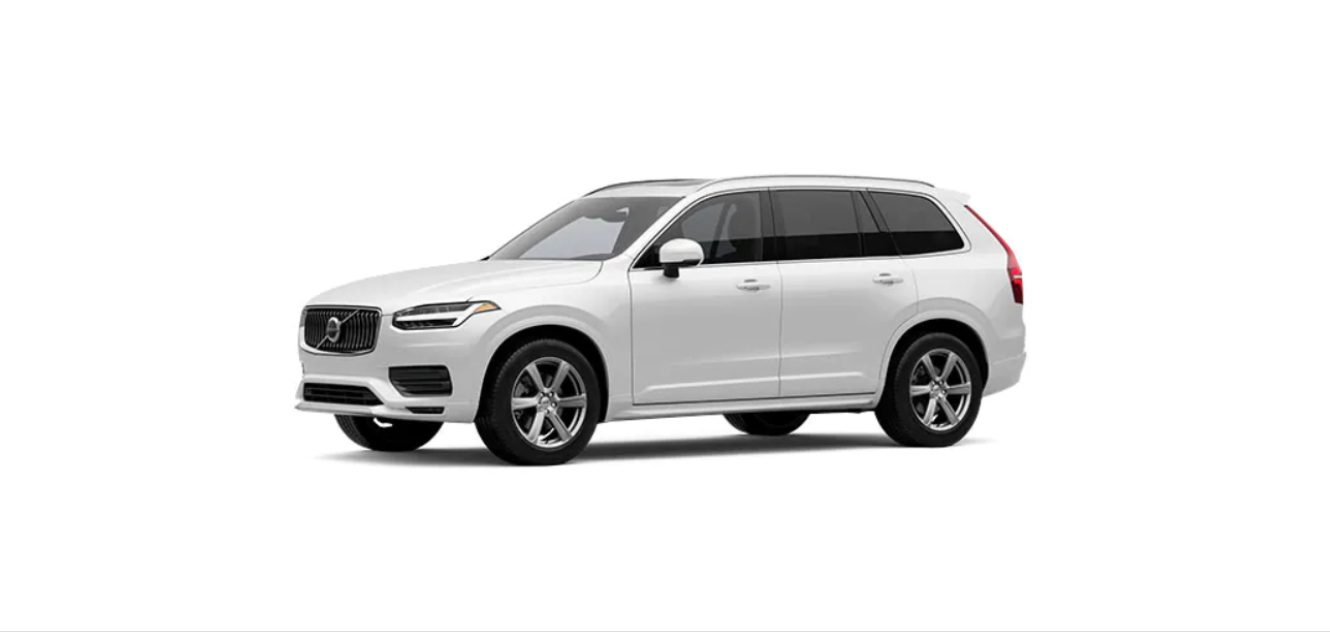2023 Volvo XC90 Recharge Plug-in Hybrid Charging the hybrid battery
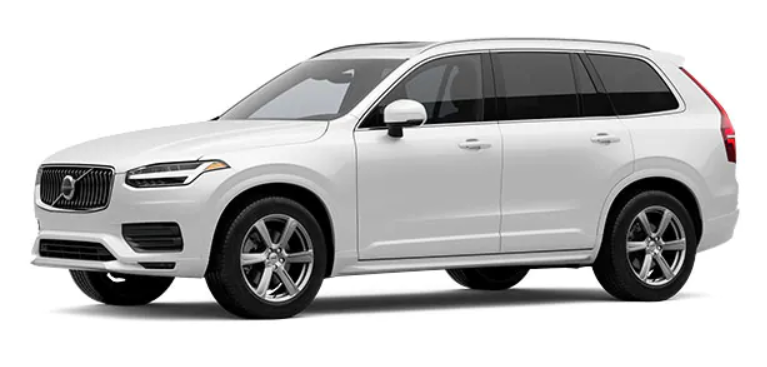
Charging status in the car’s driver display
- open one of the doors
- set the car in ignition position I by turning the START knob clockwise and releasing.
Read more in the section on driver display.
Regenerative braking
- The car recovers kinetic energy during braking in order to reduce fuel consumption and emissions.
- The function is available in all drive modes together with gear position D or B.
Activating brake regeneration
- Depress the brake pedal.
- The car brakes and regenerates energy.
- Regeneration increases during engine braking when manual gearshift mode B is selected.
Charging status in the car’s charging input socket
| LED lamp’s glow | Specification |
|---|---|
| White | Welcome light |
| Yellow | Waiting mode – waiting for charging to start. |
| Flashing green | Charging in progress. |
| Green | Charging complete |
| Red | A fault has arisen. Check the charging cable’s connection to the car’s charging input socket and power source.
Then restart charging in the following steps:
|
| Blue | Scheduled Charging activated. |
General information on the charging cable
Only use the charging cable provided with your vehicle or a replacement cable purchased from a Volvo retailer.
Charging with permanent charging cable in accordance with Mode 3
In certain locations, the charging cable is installed within a charging station connected to the mains power circuit. Therefore, use the charging station’s charging cable and follow the instructions at the charging station.
| Specifications, charging cable | |
|---|---|
| Ambient temperature | –32 ºC to 50 ºC (-25 ºF to 122 ºF) |
Warning
- Children should be supervised when in the vicinity of the charging cable when it is plugged in.
- High voltage in the charging cable. Contact with high voltage can cause death or serious personal injury.
- Do not use the charging cable if it is damaged in any way. A damaged or inoperative charging cable must only be repaired by a workshop – an authorised Volvo workshop is recommended.
- Always position the charging cable so that it will not be driven over, stepped on, tripped over or damaged in some other way, or cause personal injury.
- Do not connect one or more adapters of any type between charging cable and car.
Also, refer to the manufacturer’s instructions for using the charging cable and its components.
- Always stop charging first before unplugging the charging cable from the car’s charging input socket and then from the charging station.
- Clean the charging cable with a clean cloth, moistened with water or a mild detergent. Do not use chemicals or solvents.
The charging cable and its associated parts must not be swamped or immersed in water.
Ground fault breaker in charging cable
Warning
- Charging the car must only take place with approved, grounded wall sockets. If the capacity of the electric circuit or electrical socket is unknown, contact a qualified electrician to check the capacity of the electric circuit. Using a charge level that exceeds the capacity of the electric circuit or electrical socket may cause fire or damage the electric circuit.
- The charging cable’s ground fault breaker helps to protect the car’s charging system, but cannot guarantee that overload will never occur.
The ground fault breaker does not protect the wall socket/electrical installation.
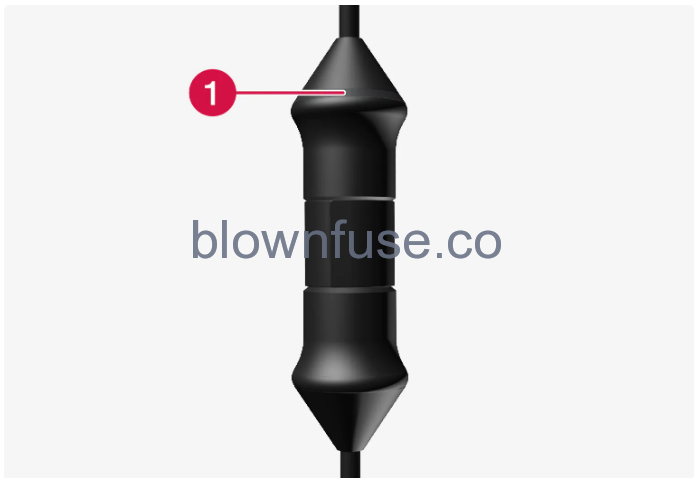 Control unit LED lamp.
Control unit LED lamp.
- LED lamp
If the control unit’s built-in ground fault breaker is tripped then the LED lamp illuminates with a red constant glow – check the wall socket. Ask a licensed electrician to check the socket or try to use another electrical socket.
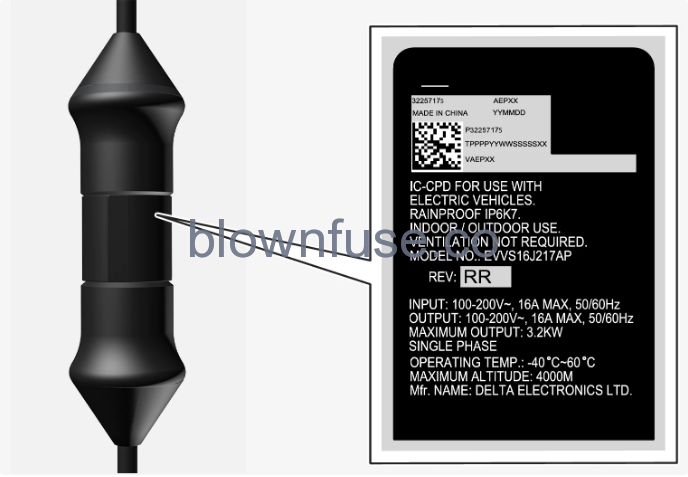
Important
- Check the capacity of the socket.
- Other electronic equipment connected to the same fuse circuit must be disconnected if the total load is exceeded.
- Do not connect the charging cable if the socket is damaged, worn or defective.
Charging status in the charging cable’s control unit
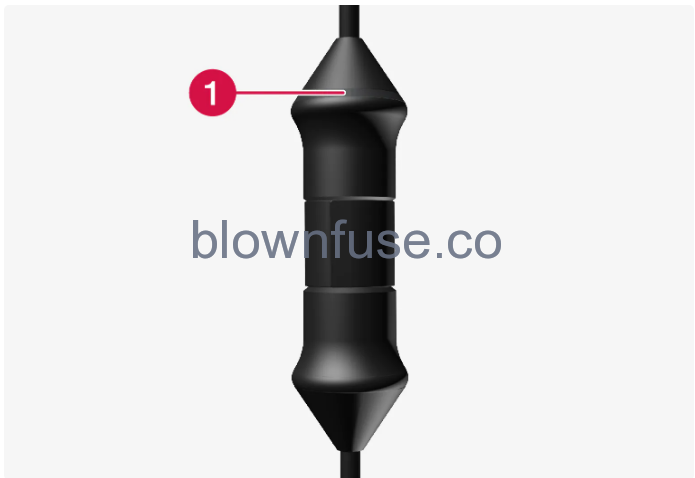 Control unit LED lamp.
Control unit LED lamp.
- LED lamp
Ensure that the charging cable is handled according to recommendations and instructions by reading the enclosed instructions.
| LED | Status | Specification | Recommended action |
|---|---|---|---|
| Extinguished | Charging is not possible. | No power supply to charging cable. |
|
| White light | Charging possible. | The charging cable is ready to be plugged into the car. |
If the LED lamp is white but charging is not possible:
|
| Flashes white | Charging in progress. | The car’s electronics have started charging
Charging in progress. |
Wait until the car is fully charged. |
| Illuminates in red | Charging is not possible. | Temporary fault. |
|
| Flashes red | Charging is not possible. | Critical fault. |
|
Charging cable temperature monitoring
- For the car’s hybrid battery to be charged safely every time, the control unit for the charging cable and the plug have built-in monitoring devices for the temperature.
- Temperature monitoring takes place in the control unit and the plug.
Charging is switched off if the temperature of the control unit is too high. This is to protect the electronics. This may take place in a high outside temperature, for example, or when strong sunlight shines directly on the control unit.
Monitoring at the plug
- The charging current is reduced if the temperature at the plug is too high. If the temperature exceeds a critical level, charging is stopped completely.
- If the temperature monitoring has automatically lowered the charging current repeatedly and charging has been interrupted then the cause of the overheating must be investigated and rectified.
- Avoid exposing the control unit and its plug to direct sunlight. In such cases, the overheating protection in the plug is at risk of reducing or interrupting the charging of the car.
- If charging is unintentionally stopped, both the charging cable and the car’s charging system should be checked by a trained and qualified Volvo service technician. The wall socket should also be checked by a licensed electrician.
Charging a hybrid car via a wall socket
The information in this section refers to charging via a wall socket and a mode 2 charging cable.
When charging via a wall socket, use a charging cable with a control unit than can limit the amperage (mode 2).
Volvo recommends a charging cable in accordance with IEC 62196 and IEC 61851 which supports temperature monitoring.
Only use the charging cable provided with your vehicle or a replacement cable purchased from a Volvo retailer.
- The charging cable has a built-in circuit breaker. Charging must only take place with grounded and approved sockets.
- Children should be supervised when in the vicinity of the charging cable when it is plugged in.
- High voltage in the charging cable. Contact with high voltage can cause death or serious personal injury.
- Do not use the charging cable if it is damaged in any way. A damaged or inoperative charging cable must only be repaired by a workshop – an authorised Volvo workshop is recommended.
- Always position the charging cable so that it will not be driven over, stepped on, tripped over or damaged in some other way, or cause personal injury.
- Disconnect the charger from the wall outlet before cleaning it.
- Never connect the charging cable to an extension cord or a multiple plug socket.
- Do not use one or more adapters between the charging cable and the electrical socket.
- Do not connect one or more adapters of any type between charging cable and car.
- Do not use an external timer between the charging cable and the electrical socket.
Also, refer to the manufacturer’s instructions for using the charging cable and its components.
Plug the charging cable into a 230 V socket. Open the charging hatch. Note that the car must be switched off prior to charging. Remove the charging handle’s protective cover and then press the handle the whole way into the socket for the car.The charging cable’s charging handle is fastened/locked in, and charging starts within 5 seconds.
Read more about how charging is started in the section on Charging hybrid cars.
If the fuse of the wall socket has too low a current capacity, the fuse could blow while the car is charging. Contact a qualified electrician for investigation of further measures.
Warning
- The hybrid battery must only be charged at maximum permitted charging current or lower in accordance with applicable local and national recommendations for hybrid charging from wall sockets/plugs.
- Charging the hybrid battery must only take place from approved grounded wall sockets.
- Avoid visibly worn, defective or damaged mains sockets since they may lead to fire damage and/or personal injury if used.
Finish charging by unlocking the car, unplugging the charging cable from the car’s charging input socket and then from the 230 V socket.
Read more about how charging is ended in the section on Ending charging of hybrid cars.
Before the charging cable is disconnected from the car’s charging input socket, the car must be unlocked using the unlock button on the key. This must be carried out even if the doors on the car are already unlocked. If the car is not unlocked using the unlock button, this may lead to damage to the charging cable or to the system.
- Never unplug the charging cable from the wall socket while charging is in progress – there is then a risk of damaging the wall socket.
- Always unlock the car so that charging is stopped before the connection to the wall socket is unplugged.
- Note that the charging cable must be unplugged from the car’s charging input socket before being unplugged from the wall socket, partly to avoid damage to the system, and partly to avoid stopping the charging unintentionally.
Charging a hybrid car via a wall socket corresponds to a high load on the fuse.
Important
- Ensure that the wall socket fuse can handle the specified amperage for the charging cable.
- Normally several 230 V consumers are included in a fuse circuit, so additional consumers (e.g. lighting, vacuum cleaner, electric drill, etc.) can be on the same fuse.
- Check that the 230 V socket has adequate power capacity for charging electric vehicles – in the event of uncertainty, the socket must be checked by a qualified professional.
Charging a hybrid car
Starting charging
- Disconnect the charging cable from the charging station storage socket or take out the charging cable. Note that the car must be switched off prior to charging.
- Plug the charging cable into the charging station. If the charging station has a permanent charging cable, skip to step 3.
Avoid plugging in the charging cable when there is a risk of a thunderstorm or lightning strikes.
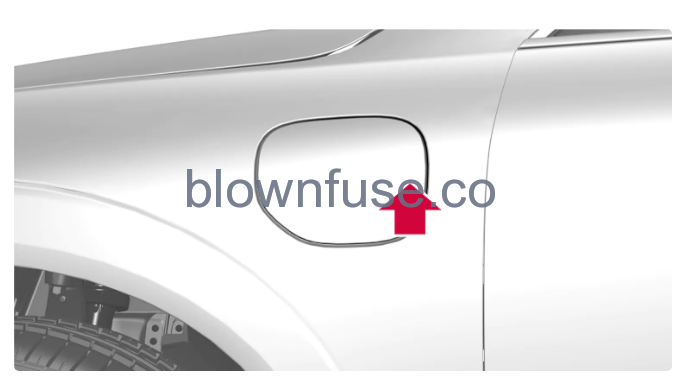
Press in the rear section of the cover to open the charging hatch.
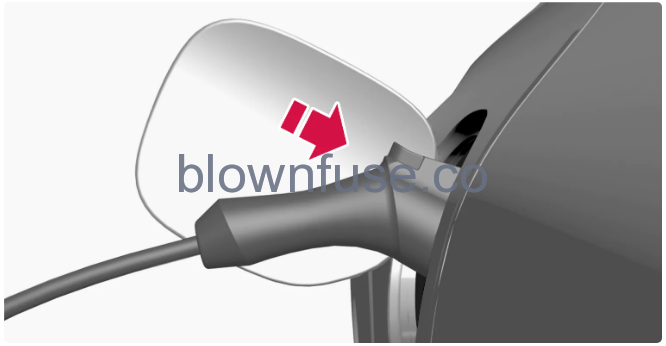
Remove the charging handle’s protective cover and press the charging handle the whole way into the socket for the car.
Important
- To avoid damage to the paint, e.g. in the event of high winds, position the charging handle’s protective cover so that it does not touch the car.
- The charging cable’s charging handle is fastened/locked in, and charging starts within 5 seconds.
- When charging has started, the LED lamp in the charging input socket flashes with a green glow.
- The driver display shows the remaining estimated charging time or whether charging is not working as intended.
- Condensation from the air conditioning may drip under the car during charging. This is normal and takes place due to cooling of the hybrid battery.
Warning
- Children should be supervised when in the vicinity of the charging cable when it is plugged in.
- High voltage in the charging cable. Contact with high voltage can cause death or serious personal injury.
- Do not use the charging cable if it is damaged in any way. A damaged or inoperative charging cable must only be repaired by a workshop – an authorised Volvo workshop is recommended.
- Always position the charging cable so that it will not be driven over, stepped on, tripped over or damaged in some other way, or cause personal injury.
- Do not connect one or more adapters of any type between charging cable and car.
Also, refer to the manufacturer’s instructions for using the charging cable and its components.
Do not wash the car when the charging cable is connected or when the charging hatch is open.
Ending charging of a hybrid car
- End charging by unlocking the car, unplugging the charging cable from the car’s charging input socket, and then the charging station.
- Unlock the car using the key. Charging is ended and the charging cable’s locked handle releases/unlocks.
Always stop charging first before unplugging the charging cable from the car’s charging input socket and then from the charging station.
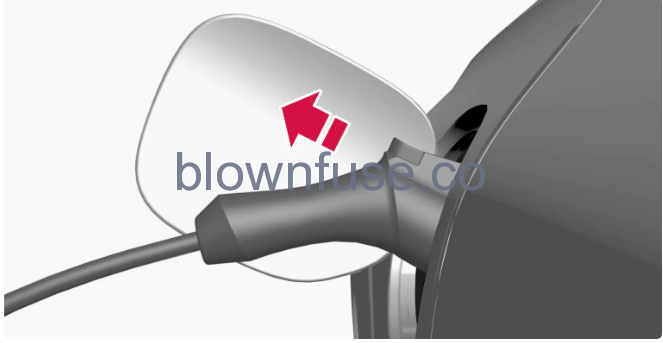
- Unplug the charging cable from the car’s charging input socket and close the hatch.
- Unplug the charging cable from the charging station, or plug the permanent charging cable into the charging station’s storage socket.
Always unlock the car so that charging is stopped before you unplug the charging cable. Note that the charging cable must be unplugged from the car’s charging input socket before being unplugged from the charging station, partly to avoid damage to the system, and partly to avoid stopping the charging unintentionally.
Charging time
| Current intensity (A) | Charging power (kW) | Charging time (hours) |
|---|---|---|
| 6 | 1,3 | 12 |
| 10 | 2.2 | 7 |
| 16 | 3,6 | 5 |
Note
- Charging power and charging time may vary depending on voltage level and whether another load is connected into the same circuit.
- When using a charging station with an output higher than 3.6 kW, the maximum capacity of the hybrid car is 3.6 kW.
- If the weather is very hot or very cold, some of the charging current is used to heat/cool the hybrid battery, which results in a longer charging time. If the parking heater is active then part of the charging current is also used.
